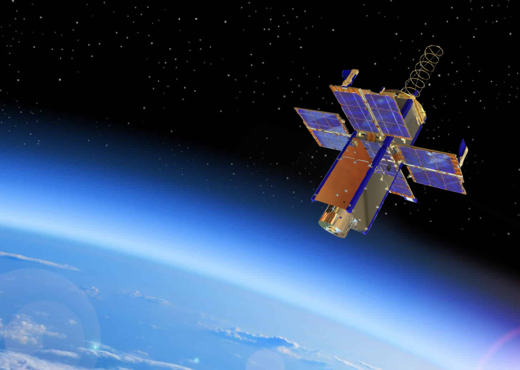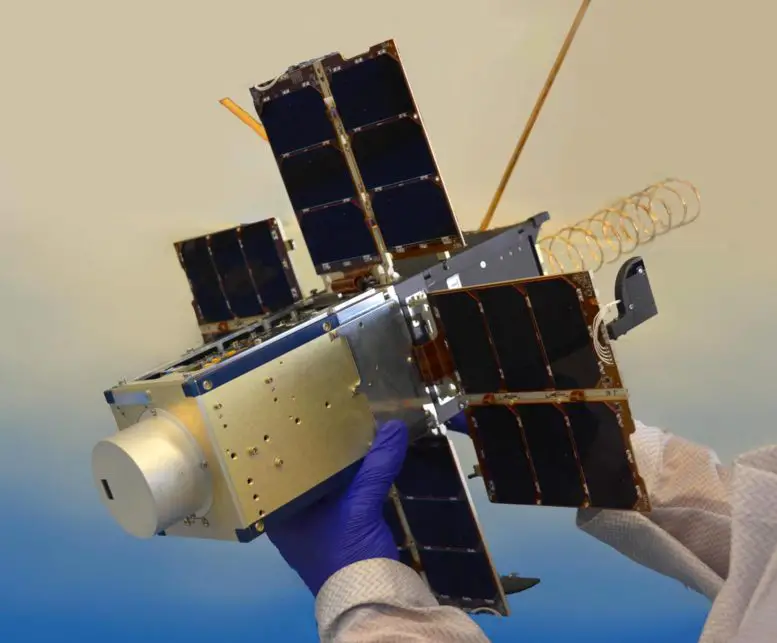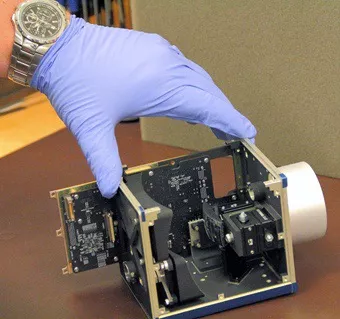NACHOS (Nano-satellite Atmospheric Chemistry Hyperspectral Observation System)
EO
Atmosphere
Aerosols
Aerosol optical depth (column/profile)
NACHOS (Nano-satellite Atmospheric Chemistry Hyperspectral Observation System) is a pair of high-resolution hyperspectral imaging CubeSats developed by Los Alamos National Laboratory (LANL) and NASA to help climate and volcanic research. The satellites were launched in February and July 2022, each with a design life of three to five years.
Quick facts
Overview
| Mission type | EO |
| Agency | NASA, LANL |
| Mission status | Operational (nominal) |
| Launch date | 19 Feb 2022 |
| Measurement domain | Atmosphere |
| Measurement category | Aerosols, Ozone, Trace gases (excluding ozone) |
| Measurement detailed | Aerosol optical depth (column/profile), Aerosol Extinction / Backscatter (column/profile), O3 Mole Fraction, NO2 Mole Fraction, BrO (column/profile), SO2 Mole Fraction, Aerosol Single Scattering Albedo, SO2 Total Column, O3 Total Column, NO2 Total Column |
| Instruments | NACHOS Hyperspectral Imager |
| Instrument type | Hyperspectral imagers |
| CEOS EO Handbook | See NACHOS (Nano-satellite Atmospheric Chemistry Hyperspectral Observation System) summary |

Summary
Mission Capabilities
On board each NACHOS satellite is the NACHOS-Imager developed by LANL which uses an ultraviolet/visible grating spectrometer to produce hyperspectral imagery of trace gases using a pushbroom scanning technique. The NACHOS satellites will target nitrous oxide, sulfur dioxide, ozone, formaldehyde, and other gases with high spectral resolution to separate the trace gas signatures from the atmosphere. This allows researchers to gather data on atmospheric trace gases with small satellites, reducing the overall mission cost and increasing revisit time.
Performance Specifications
The spectrometer has a spectral range of 290-500 nm, a 1.2 nm resolution and 0.6 nm sampling, giving 350 channels. At an orbit of 500 km it has a resolution of 0.4 km and a swath of approximately 140 km. NACHOS-2 is at an altitude of 485 km, inclination of 45° and an orbital period of 94.1 minutes. NACHOS-1 is at an altitude of approximately 400 km at an inclination of 52°.
Space and Hardware Components
The NACHOS spacecraft are 3U CubeSats consisting of a 1.5U Prometheus Block-2 CubeSat and the 1.5U NACHOS experiment module, both developed by LANL. Each NACHOS satellite has a mass of 6.25 kg (they have an unusually high mass for a 3U CubeSat due to 2 kg ballast onboard to increase the orbital lifetime of the satellite). NACHOS uses newly developed, computationally efficient algorithms that can rapidly extract gas signatures from massive hyperspectral datasets, taking just minutes to do so on the onboard computer.
Overview
Nano-satellite Atmospheric Chemistry Hyperspectral Observation System (NACHOS) is a pair of experimental CubeSats created by the Los Alamos National Laboratory (LANL) to carry out high-resolution hyperspectral photography of trace gases. These observations will assist with research in climate change and volcanology. There is a long-term vision for a constellation of NACHOS satellites. 1)
NACHOS is the first-ever cubesat-based hyperspectral imaging system that can compete with traditional large-satellite instruments in chemical detection applications. It will also be the smallest satellite dedicated to monitoring atmospheric trace gases like sulphur dioxide (SO2) and nitrogen dioxide (NO2), paving the way for future Earth-observing systems that will not only help predict volcanic eruptions, but also monitor air quality around specific cities, neighbourhoods, and even individual power plants. 2) 3)
Spacecraft
NACHOS is a 3U CubeSat consisting of a 1.5U Prometheus Block-2 CubeSat and the 1.5U NACHOS experiment module, both developed by LANL. NACHOS has an overall mass of 6.25 kg. This unusually high mass for a 3U CubeSat is due to the 2 kg ballast installed to increase the orbital lifetime. 4)

Prometheus is a series of 1.5U CubeSats for technology development and demonstration. It was developed by LANL with the dual objective of evaluating new low-cost development and operations methodologies while also assessing the operational utility that can be provided with CubeSat technology. The program was funded by the US Department of Defence.
The Prometheus system consists of CubeSats along with the supporting ground and field segment equipment, all designed as an integrated system. LANL is the primary builder and system integrator and will perform the on-orbit system checkout, tests, and evaluation. The NACHOS satellites were based on the earlier Prometheus and Perseus satellites developed by Dauria Aerospace.
Each Prometheus satellite costs less than $100,000, and has an expected service life of three to five years. They demonstrate the capability to transfer audio, video, and data files from man-portable, low-profile, remotely located field units to deployable ground stations terminals using over-the-horizon satellite communications. Each satellite features four deployable solar arrays and a deployable helix antenna. The second generation Prometheus Block 2 satellites that NACHOS are based off feature several improvements. The solar arrays have been enlarged and the attitude control system has been improved. A star field sensor and a GPS receiver were added. Also they provide the opportunity for hosted payloads, as a 1.5U payload module can be added to each satellite. 5)
While hyperspectral imaging is a powerful technique, it produces vast amounts of data that can take hours to downlink in raw form. So, another crucial goal of these tests is to assess NACHOS' unique onboard image-processing capability, which will drastically shorten the time it takes to downlink. NACHOS uses newly developed, computationally efficient algorithms that can rapidly extract gas signatures from massive hyperspectral datasets, taking just minutes to do so even on the cubesat's tiny computer. 7)
Launch
NACHOS-1
NACHOS-1 was launched aboard Antares-230 on February 19, 2022, from Wallops Flight Facility in Wallops Island, Virginia towards the International Space Station (ISS) before being deployed to its final orbit on June 30. 8)
Orbit: NACHOS-1 was in a sun-synchronous orbit at an altitude of approximately 400 km and an inclination of 52°.

NACHOS-2
NACHOS-2 satellite launched directly to its orbit aboard a Virgin Orbit LauncherOne rocket on July 2, 2022, from Western Range Air Space (WRAS).
Orbit: NACHOS-2 is in a sun-synchronous orbit, at an altitude of 485 km, inclination of 45°, and an orbital period of 94.1 minutes. 9)
Mission Status
- February 3, 2023: NACHOS-1 decays after almost one year in orbit.
- July 2021: NACHOS-1 undergoes Flight Unit host/payload integration.
Sensor Complement (NACHOS-Imager)
NACHOS-Imager is a new development by LANL to produce a trace-gas hyperspectral imaging capability on a 3U CubeSat platform using a pushbroom scanning technique. It uses a ultraviolet / visible grating spectrometer with a spectral range of 290-500 nm, a 1.2 nm resolution and 0.6 nm sampling, giving 350 channels. At an orbit of 500 km it has a resolution of 0.4 km and a swath of approximately 140 km as it has a 350-pixel swath width. 6)

References
1) “Nano-satellite Atmospheric Chemistry Hyperspectral Observation System.” Wikipedia, https://en.wikipedia.org/wiki/Nano-satellite_Atmospheric_Chemistry_Hyperspectral_Observation_System
2) Love, Steve. “Using tiny satellites to monitor harmful gases from space.” Los Alamos National Laboratory, 31 March 2022, https://discover.lanl.gov/news/0331-satellites-monitor-harmful-gases/
3) Taylor, Gage. “High-Flying NASA “NACHOS” Compact Hyperspectral Imager May Help Predict Volcanic Eruptions.” SciTechDaily, 20 February 2022, https://scitechdaily.com/high-flying-nasa-nachos-compact-hyperspectral-imager-may-help-predict-volcanic-eruptions/?utm_content=cmp-true
4) “NACHOS 1, 2 - Gunter's Space Page.” Gunter's Space Page, 14 January 2023, https://space.skyrocket.de/doc_sdat/nachos.htm
5) “Prometheus-2.” Gunter's Space Page, https://space.skyrocket.de/doc_sdat/prometheus-2.htm
6) “WMO OSCAR | Details for Instrument NACHOS-Imager.” WMO OSCAR, 18 July 2022, https://space.oscar.wmo.int/instruments/view/nachos_imager
7) Love, Steve. “Using tiny satellites to monitor harmful gases from space (op-ed).” Space.com, 31 March 2022, https://www.space.com/cubesats-monitor-harmful-gases-from-space
8) NASA, 30 July 2018, https://nssdc.gsfc.nasa.gov/nmc/spacecraft/displayTrajectory.action?id=2022-015D. Accessed 10 June 2023.
9) “NACHOS-2 Satellite details 2022-074B NORAD 52945.” N2YO.com, 2 July 2022, https://www.n2yo.com/satellite/?s=52945#results.
10) “NACHOS - NASA Earth Science and Technology Office.” NASA ESTO, https://esto.nasa.gov/invest/nachos/.